Year 1563 Artist Paolo Veronese Location The Louvre | Medium Oil on canvas Dimensions 6.77 m x 9.9 m Created 1562–1563 | |
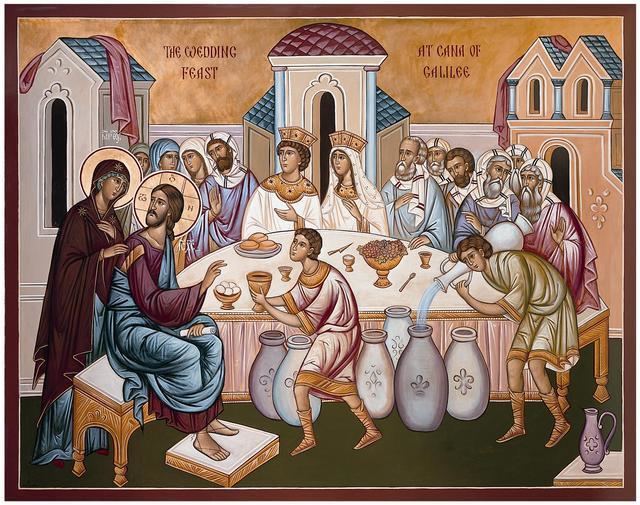 | ||
Periods Renaissance, Mannerism, Italian Renaissance Genres Christian art, History painting Similar Paolo Veronese artwork, Artwork at The Louvre, Renaissance artwork | ||
The wedding at cana veronese
The Wedding at Cana (1563, also The Wedding Feast at Cana), by Paolo Veronese, is a representational painting that depicts the Bible story of the Marriage at Cana, a wedding banquet at which Jesus converts water to wine (John 2:1–11). The work is a large-format (6.77 m × 9.94 m) oil painting executed in the Mannerist style of the High Renaissance (1490–1527); as such, The Wedding Feast at Cana is the most expansive canvas (67.29 m2) in the paintings collection of the Musée du Louvre.
Contents
- The wedding at cana veronese
- A facsimile of the wedding at cana by paolo veronese
- The subject
- The commission
- Looting and re installation
- Restoration
- The setting
- Symbolism
- Religious purpose
- Composition and technique
- References
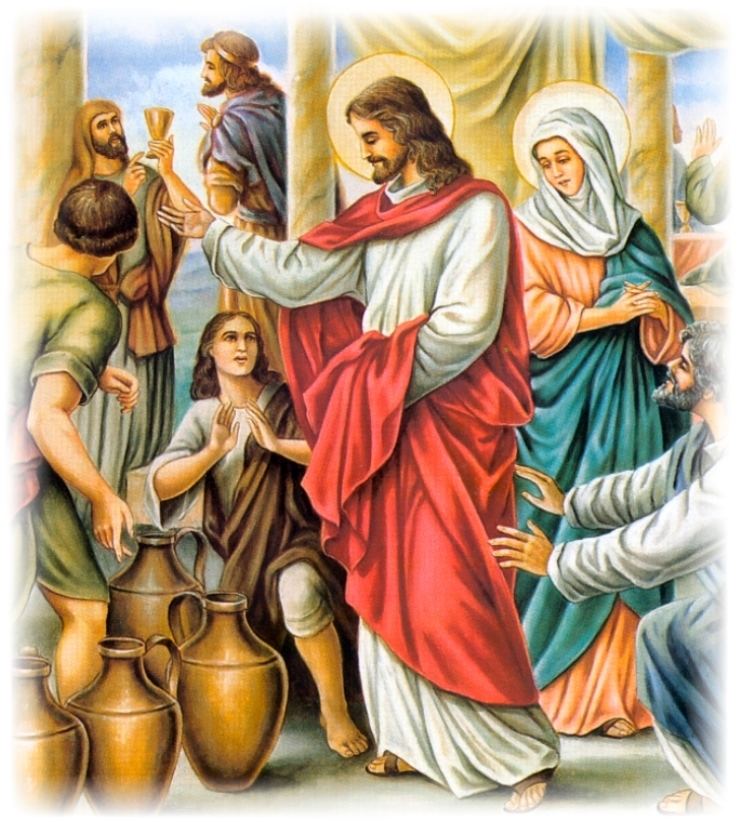
As a Mannerist painting, The Wedding at Cana comprehends the stylistic influences of the ideals of compositional harmony of artists such as Leonardo, Raphael, and Michelangelo, especially his early paintings. Whereas the art of the High Renaissance emphasized ideal proportion, balance, and beauty, Mannerism exaggerated those ideals of figure, light, and colour, with asymmetric and unnaturally elegant compositions.
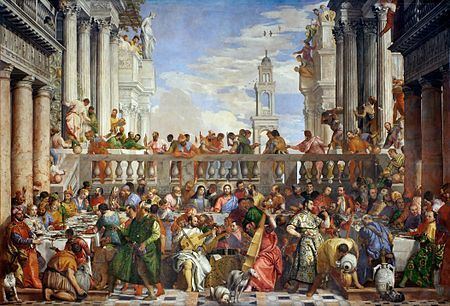
In executing the painting in the Mannerist style of compositional tension and instability, Veronese used technical artifice, social intellect, and cultural sophistication for The Wedding at Cana to tell a Biblical story to the viewer.
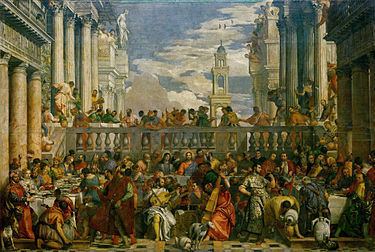
A facsimile of the wedding at cana by paolo veronese
The subject
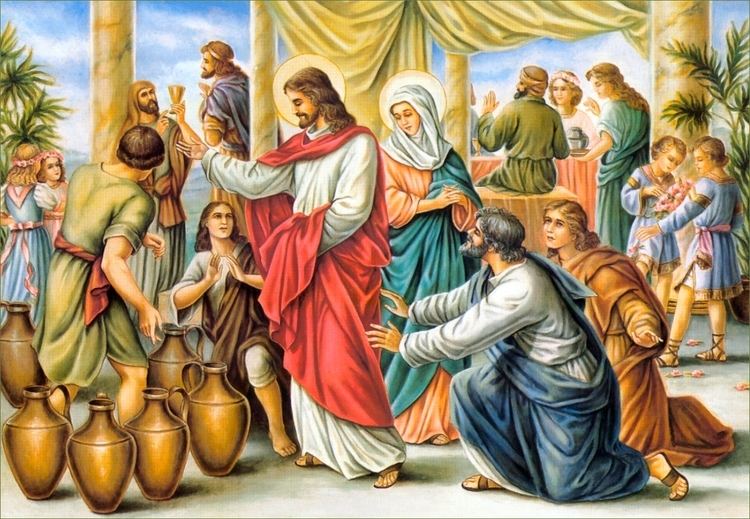
Paolo Veronese's painting of The Wedding at Cana (1563) depicts the Marriage at Cana, the nuptial banquet described in the Gospel of John, a miracle story from the Christian New Testament; the narrative relates that Mary, Jesus of Nazareth, and some of his Apostles had been invited to a wedding in the city of Cana, in Galilee. In the course of the wedding banquet, the supply of wine was exhausted, and, at the request of his mother, Jesus commanded the house servants to fill jugs with water, which he then transformed into wine (John 2:1–11).
The commission
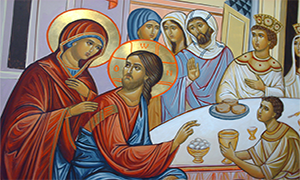
The painting of The Wedding at Cana was commissioned on 6 June 1562 to decorate the new refectory of the Benedictine Basilica of San Giorgio Maggiore, Venice; the dining hall had been designed by the architect Andrea Palladio. The business contract, between the Benedictine monks and the painter Paolo Veronese, stipulated that he was to receive 324 ducats, personal and domestic maintenance, and a barrel of wine in payment for the painting. Assisted by his brother, Benedetto Caliari, Veronese produced the biblical picture in fifteen months, and delivered the completed painting in September 1563.
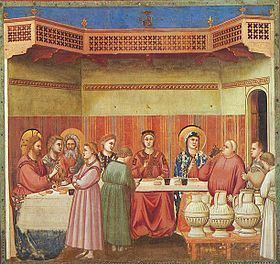
As a narrative painting in the Mannerist style, the crowded dinner-scene pictured in The Wedding at Cana was to be viewed upwards, at 2.50 metres from the refectory floor, because the over-sized dimensions (6.77m x 9.94m) and area (67.29m2) of the canvas are meant to occupy the entire display-wall. The size of the painting reflects the size of Palladio's dining-hall at the San Giorgio monastery.
Looting and re-installation
From the 16th to the 18th centuries, for 235 years, the painting decorated the dining room of the San Giorgio monastery, until soldiers of Napoleon looted it as war booty, on 11 September 1797, during the Italian campaigns of the French Revolutionary Wars (1792–1802). For the easy transport of the over-sized painting, from the Venetian monastery to Paris, the canvas of The Wedding at Cana was cut in half, to be reassembled and restitched in France. In 1798, the 235-year-old painting was stored in the first floor of the Louvre Museum; by 1803, that store of looted art had become the Musée Napoléon, the personal art collection of the future Emperor of the French.
In the early 19th century, after the Napoleonic Wars (1803–15), the restitution of looted artwork was part of the post–Napoleonic conciliation treaties; appointed by Pope Pius VII of the Vatican States, the sculptor Antonio Canova negotiated the French return of Italian artwork that Napoleon looted by way of the Treaty of Tolentino (1797); yet, on the prejudiced advice of Napoleon's curator of the museum, Vivant Denon — that the Veronese canvas was too fragile to travel from Paris to Venice — Canova excluded The Wedding at Cana from repatriation, and, in its stead, sent to Venice the Feast at the House of Simon (1653), by Charles Le Brun.
In the late 19th century, during the Franco-Prussian War (1870–71), the 300-year-old painting of The Wedding at Cana was stored in a box at Brest, in Brittany. In the 20th century, during the Second World War (1939–45), the 400-year-old painting was rolled up for storage, and continually transported to hiding places throughout southern France, lest Veronese's art become Nazi plunder.
In the early 21st century, on 11 September 2007, the 210th anniversary of the Napoleonic looting of the painting in 1797, in place of the fragile, original canvas painted by Veronese, a computer-generated facsimile of The Wedding at Cana was hung in the refectory of the Basilica of San Giorgio Maggiore, Venice. The facsimile painting (6.77m x 9.94m), composed of 1,591 graphic files, was made by Factum Arte, Madrid, on commission from the Giorgio Cini Foundation, Venice, and the Musée du Louvre, Paris.
Restoration
In 1989, the Louvre Museum began a painting restoration that provoked an art-world controversy comparable to that of the Restoration of the Sistine Chapel frescoes (1989–99). Organised as the Association to Protect the Integrity of Artistic Heritage, a group of artists protested the restoration of The Wedding at Cana, and publicly demanded to be included to the matter; which request the Louvre Museum denied. One of the controversial matters about the restoration was the removal of a red hue, over-painting the tabard of the master of ceremonies in the foreground; the cleaning revealed the original, rich-green colour of the tabard. Opponents of the restoration argued that Veronese, himself, had changed the hue to red, not liking the initial green- tone of the painting.
Three years later, in June 1992, with the restoration of the painting yet incomplete, The Wedding at Cana suffered damages in two accidents. In the first accident, the canvas was spattered with rain water from a leaking air vent. In the second accident, occurring two days later, the curators were raising the 1.5-ton painting to a higher position upon the display-wall when a support-frame failed, and the painting fell to the floor. In the fall, the metal framework used to hold and transport the painting punctured and tore five holes in the canvas; nonetheless, the punctures and tears affected only the architectural and background areas of the painting, and not the faces of the characters.
The setting
The water-into-wine episode of the life of Jesus is represented in the grand style of the sumptuous feasts characteristic of contemporary Venetian society; the banquet scene of The Wedding at Cana is a mixture of architectural details from Classical Antiquity and the Renaissance, the contemporary era of the painter. The architecture is Græco–Roman, featuring Doric and Corinthian columns surrounding a courtyard enclosed with a low balustrade; beyond the courtyard, there is an arcaded tower in the distance, designed by the architect Andrea Palladio. In the foreground, a group of musicians play Late–Renaissance instruments (lutes and stringed instruments).
According to tradition, the painter (Paolo Veronese) included himself in the banquet scene; he would be the musician in white tunic, who is playing the viola da gamba. Behind him are the painters Jacopo Bassano, playing the flute, and Tintoretto, playing the violin, while directly opposite is Titian, dressed in red, playing the violoncello.
The guests to the wedding banquet include historical personages such as Eleanor of Austria, Francis I of France, and Mary I of England, Suleiman the Magnificent, Vittoria Colonna, the Emperor Charles V, and Marcantonio Barbaro, Daniele Barbaro, Giulia Gonzaga, Cardinal Pole, the master jester Triboulet, and Sokollu Mehmet Paşa — all are sumptuously dressed at the height of contemporary fashion; some of the guests are dressed in Oriental garments.
Symbolism
The picture of The Wedding at Cana is in two parts:
I. On the horizontal axis — the lower part of the painting contains 130 human figures, while the upper part of the painting is dominated by the Geæco–Roman architecture that frames and contains the historical figures and popular personages of the Late Renaissance who were invited to the biblical wedding meal. In the Mannerist style, some characters are rendered in foreshortened perspective; the architectural elements mirror buildings designed by Andrea Palladio; the treatment is a cosmopolitan tableau of historical and contemporary personages dressed in the costumes of the Occidental and the Oriental worlds known to Renaissance society; as such, The Wedding at Cana (1563) was a modern-era painting.
Seated behind the musicians are Mary, Jesus of Nazareth, and some of his Apostles; they are dressed in Biblical-era garments in soft colours. Moreover, of the characters in the Biblical story and the Renaissance painting, Jesus is the only guest who looks directly at the viewer of the painting The Wedding at Cana. Above the Jesus figure, on an elevated walkway, a man watches and a serving maid awaits for a butcher to cut up an animal; while, to the right, a porter arrives with more meat for the feasting diners to eat. The butchered animals prefigure the sacrifice of Jesus, as the Lamb of God, as he is aligned directly beneath the butcher's block and blade.
At the bottom-right-side of the picture, a barefoot manservant pours red wine from a large, ornate oenochoe into a serving pitcher. Behind the manservant stands Benedetto Caliari (brother of Veronese) who is intently considering the red wine in the glass. At the bottom-left-side, a dark-skinned, servant boy proffers a glass of the red wine to the bridegroom; at the edge of their table a dwarf holds a bright green parrot, as he awaits instructions from the merchant dressed in dark green. Although many of the guests in The Wedding at Cana hold glasses of wine, no-one appears drunk.
II. On the vertical axis — with the contrast of light and shadow, the picture symbolizes the co-existence of mortality and the earthly pleasures; above the Jesus figure, a lamb is butchered, beneath the Jesus figure there are musicians, and before them is an hourglass, a reference to the futility of human vanity. As a function of the painting, the protocol of religious symbolism supersedes the social protocol for a wedding banquet; thus, the disparity of status, between the celebrants and the guests: Jesus, Mary, and some of his Apostles sit at the centre span of the banquet table, whilst the bride and bridegroom sit at the right wing of the banquet table. Moreover, despite the continuing preparation of roasted-meat, the main course of a meal, the guests appear to be eating the dessert course of the meal, given that the foods on the table include fruits and quince cheese, a comestible symbol of marriage; such a culinary contradiction indicates that the animals are symbolic and not for eating.
Religious purpose
Despite the painting showing more than one hundred guests in the banquet, of all the people who crowd the scene with human gesture, colour of character, and social pose, no-one is speaking. The silent crowd scene is a creative condition of Veronese's Benedictine commission for a painting meant to hang in a silent dining room — the refectory of a monastery on a Venetian island. Beyond the frame of Græco–Roman architecture, the earthly, Italian background is a blue sky, bright with white clouds, a stylistic detail meant to illuminate, expand, and deepen the viewer's perspectives of the time, the place, and the personages invited to The Wedding at Cana.
In the event, Paolo Veronese's Mannerist execution of the water-into-wine episode of the life of Jesus, made The Wedding at Cana (1563) a scandalous work of art among Venetian society; the painting's thematic emphasis of the hedonistic aspects of feasting, at the expense of the pious aspects of a sacramental subject, countered the professed sensibilities of the Republic of Venice in the Late Renaissance.
Composition and technique
Among artists, the number of human figures considered apt for a representational painting of a group of people was controversial — as art and as commerce; in the 17th century, Andrea Sacchi (1599–1661) said that only a few figures (fewer than twelve) permit the artist to honestly depict the unique expression of a character, while Pietro da Cortona (1596–1669) said that many human figures visually consolidate the general image of a painting; and, in the 18th century, in the Seven Discourses on Art (1769–90), Joshua Reynolds (1723–92), said that:
The subjects of the Venetian painters are mostly such as gave them an opportunity of introducing a great number of figures, such as feasts, marriages, and processions, public martyrdoms, or miracles. I can easily conceive that [Paolo] Veronese, if . . . asked, would say that no subject was proper for an historical picture, but such as [one that] admitted at least forty figures; for in a less number, he would assert, there could be no opportunity of the painter's showing his art in composition, his dexterity of managing and disposing the masses of light, and groups of figures, and of introducing a variety of Eastern dresses and characters in their rich stuffs.
Moreover, The Wedding at Cana (1563) was not Paolo Veronese's only sally into the depiction of many people; ten years later, he painted The Feast in the House of Levi (Christ in the House of Levi, 1573), which also depicts a crowded banquet meal. For such commissioned paintings, and as a practical matter of business, the patron or patroness usually paid the painter by the figure. Nonetheless, despite such commercial conditions, the commission for The Feast in the House of Levi was an opportunity for Veronese to concentrate on festive coloration, and to demonstrate his compositional skill, without having to exaggerate the gestures of characters to convey meaning. Painting crowds, however, was politically risky, especially when the theological and political symbolism — the presence of dogs and sundry persons — in The Feast in the House of Levi drew the attention of the Inquisition, who summoned Veronese to explain himself, the painting, and art.
